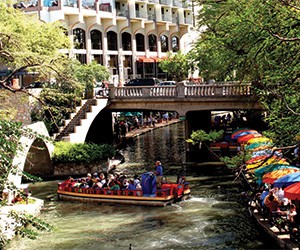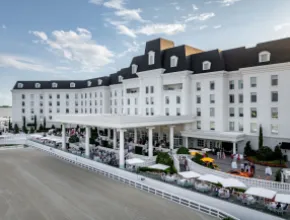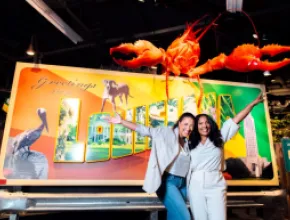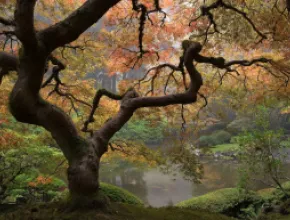Like the San Antonio CVB’s distinctive quatrefoil logo, this Old World Texas citadel—named "one of America’s four unique cities" by Mark Twain—unfolds invitingly in all directions.
At night, River Walk magically meanders through downtown, and in the heat of day, Mission San Jose and her sister churches are reminiscent of 18th century Spain. The southern gateway to Hill Country, Alamo City’s sprawl of enticing neighborhoods even has its own "West Side" story.
Take the VIA streetcar west along Commerce Street, past the circa-1731 San Fernando Cathedral and circa-1749 Spanish Governor’s Palace, to Market Square, heart of the historic West Side. Here, amid majestic murals, museums and theaters, the soul of "El Mercado" is found at Mi Tierra Cafe y Panaderia, crown of a dining dynasty that originated with Guadalajaran emigre Pedro Cortez’s three-table cafe in 1941. Along with his wife "Mama" Cortez, Pedro determinedly led the transformation of the once-blighted El Mercado. Perpetuating their legacy today is Jorge Cortez, one of their five children and a cherished son of San Antonio.
"What makes the city beautiful and welcoming are the generations of different cultures that have settled here," Cortez says. "San Antonio, like Mi Tierra and El Mercado, is the story of cultura and familia."
Hospitality is also economic lifeblood, employing over 106,000 people, generating an impact of around $11 billion and growing nearly 70 percent over the last decade. With tourism and conventions prominent in its industry mix, San Antonio’s stamina is undiminished after capably weathering the recession.
"The hospitality community has invested billions in the past few years to ensure San Antonio remains one of the top meeting destinations in the country," says Scott White, executive director of the San Antonio CVB. "From new and newly renovated hotels and resorts to our recently expanded River Walk, meeting professionals have an abundance of options to choose from."
In the state’s most-visited city, roads and rivers are historical voyages and cultural journeys. Richly layered and supremely authentic, utterly welcoming and irresistibly entertaining, San Antonio is a fiesta for the senses.
Mission Statements
San Antonio showcased its convention might this July by hosting its largest event ever, the 2010 International Convention of Alcoholics Anonymous. Garnering an estimated 60,000 attendees from more than 90 countries, the four-day gathering, jointly convened at the Alamodome and Henry B. Gonzalez Convention Center, was a triumph of planning and logistics. Among the numbers: 115 hotels and over 200 motorcoaches utilized to house and move attendees; over 19,000 sandwiches and 96,000 bottles of water sold at the convention center; and nearly 40,000 delegate rides on River Walk river cruisers. Worth an estimated $65 million to the local economy, the event affirmed the CVB’s ability, as White states, "to provide answers to your daunting questions."
With a healthy mix of repeat customers and new national and regional conventions, San Antonio continues to operate at one of the highest occupancy levels of convention centers in the U.S.
"The group outlook for 2011 is very positive and shows a trend upward from the previous two years," says Michael Sawaya, the city’s director of convention, sports and entertainment facilities. "Future bookings are solidly ahead of pace, and consideration of future facility development opportunities is currently being studied."
With other large-scale venues including historic Sunset Station, San Antonio continuously invests in convention facilities to meet its goal of staying at the forefront of the convention industry. Hotel expansion figures in the plan, too. Now offering more than 42,000 rooms citywide, San Antonio’s well-distributed lodging is abundant, affordable and diverse.
Many of downtown’s 12,700-plus rooms front River Walk, the "world’s largest hotel lobby," with around 6,500 rooms within walking distance of the convention center. Sophisticated luxury is a hallmark: San Antonio leads Texas and ranks fourth in the nation behind New York, San Francisco and Chicago with 20 AAA Four Diamond-rated properties. Downtown gems include Grand Hyatt San Antonio, Hotel Contessa, Omni La Mansion del Rio and Hotel Valencia, while Four Diamond jewels in the Hill Country environs include Hyatt Regency Hill Country Resort and Westin La Cantera Resort.
Also attracting notice is the new JW Marriott San Antonio Hill Country Resort & Spa—the brand’s first Texas property and largest in the world.
"The resort has exceeded expectations in its first six months since opening its doors and has expanded San Antonio’s already well-known hospitality offerings into the charming Texas Hill Country," says Arthur Coulombe, general manager of the resort.
History of a different caliber is served at the Menger Hotel. Constructed in 1859, this evocative, 316-room property, just steps from the Alamo, was a Wild West hell-raiser in its time. Barbed wire was first sold here, and while Teddy Roosevelt verifiably recruited his famed Rough Riders in the Menger Bar, did he really shoot those holes in the barroom’s walls?
Alluring, too, is the circa-1906 Fairmount Hotel. Raised from its original foundations and transported to the edge of La Villita National Historic District in 1985, this 37-room Victorian charmer is reportedly the largest structure ever moved on wheels. Also on the vintage front, the recently opened, 91-room Hotel Indigo occupies San Antonio’s first office tower, the circa-1909 Gibbs Building.
Culture Connection
Cortez’s recollection of the original El Mercado cultura that he and his family work tirelessly to preserve is cinematic in its imagery: selling bananas with his siblings on the old Produce Row amid the daily market hustle, seeing stars from Mexico, Spain and Latin America perform on local screens and stages, listening to street music long into the night.
"So much color, so much ambience, so much life," he says nostalgically.
Cortez exemplifies San Antonio’s dedication to cultural preservation.
"We’re fortunate that our industry and community understand the importance of preserving and protecting our authentic culture," White says.
Event-capable cultural access points abound. Signature choices include McNay Art Museum and Witte Museum, along with Blue Star Arts Complex, Institute of Texan Cultures and Southwest School of Art & Craft, originally a convent dating to 1851. The Smithsonian-affiliated Museo Alameda is an El Mercado cultural anchor. The Buckhorn Saloon & Museum and Texas Ranger Museum make for eclectic fun, including the latter’s Bonnie and Clyde exhibit. Urban cowboys have country music and bull-riding events in town at Cowboys Dancehall or can head for authentic Hill Country destinations including Enchanted Springs Ranch and Rio Cibolo Ranch.
"Whether for visitors or meeting delegates, San Antonio’s culture reigns front and center, and one of the best ways to immerse your meeting in the culture is during one of our annual fiestas," says Dee Dee Poteete, director of communications for the San Antonio CVB.
Early November marks the colorful Dia de los Muertos (Day of the Dead) celebrations. For 11 days in April, Fiesta San Antonio takes over the city, including the flamboyant Battle of Flowers Parade. Among many other events throughout the year, December’s spellbinding Fiesta de las Luminarias features thousands of candles and lights illuminating the River Walk, while Wurstfest and Oktoberfest recognize the city’s German roots.
"Whenever you come, there’s always something uniquely San Antonio that can spice up every itinerary," Poteete says.
It’s the cultura, amigos. The familia awaits with open arms.
Remembering Alamo City well, regular Meetings South contributor Jeff Heilman looks forward to continuing his Texas journeys.







